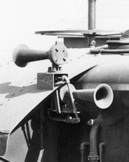







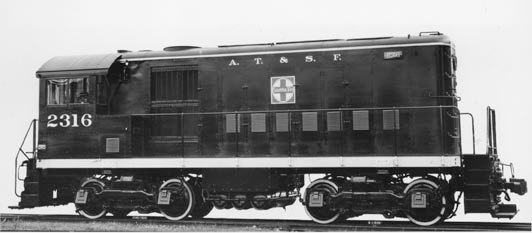
ALCo High Hood Models
The American Locomotive Co. (ALCo) HH-1000s are a modeling challenge. In 2009, Atlas Model Railroad Co. brought the first ALCo high hood, the HH-660. This beautiful model is the first of its kind in plastic and comes DCC ready or sound-equipped. The HH-600/660 (the designation depended on the horsepower rating required by the customer) shares a similar carbody with HH-1000 (which is the turbocharged version delivering 1000hp), except the HH-1000 had a longer wheelbase to accommodate a larger radiator. The difference was about 30 inches. In the model photos below, you can see the difference marked by the red lines:
An ALCo HH-1000 sits in a nearly empty First Street yard in Los Angeles. The Santa Fe’s 2310 class engines were yard and industry workhorses all around the LA basin.
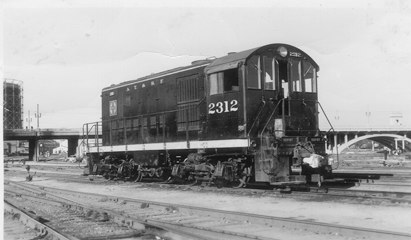
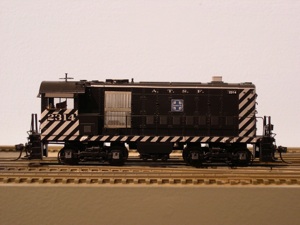
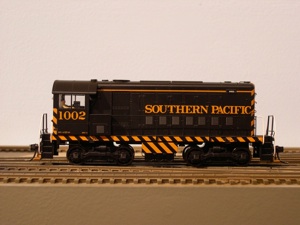


The Atlas HH-600 is at top left and scales out about 2 feet shorter than the Overland Models brass HH-1000 at lower left. The silver rectangle on the 2314 is the radiator, which is black on SP 1002, making it hard to compare the two. The models were posed at the exact same spot and the photos taken with a tripod.
The HH-1000 has never been done in plastic, to my knowledge, only in brass by Hallmark, E&P Associates and most recently by Overland Models (1999). I was fortunate to be able to find and purchase two of the Overland versions, as they are fairly rare. The first one I bought was the later blue and yellow scheme, which I thought I would repaint into zebra stripes, but subsequently found one with that paint scheme. I probably won’t repaint the blue and yellow one now.
Prior to this, I had considered “kitbashing” an older Hallmark body onto a Proto 2000 S-1 mechanism. The result would have been a fairly close model, being off in the wheelbase, which is unfortunate because one of the distinctive features of the ALCo high hoods is the cab overhanging the rear truck to a large degree.
Playing with CVs
Once I had the decoder and speaker installed, tested and started running, I began changing the various CVs (configuration variables), trying to understand how the Tsunami worked and reacted.
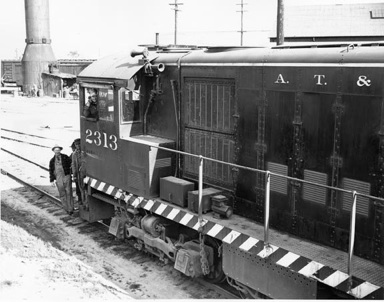
I then began changing the speed variables, trying to get slow, smooth starts and stops, while the turbocharger would wind up or down, simulating a real locomotive. I did all of this at the EasyDCC command station, never recording my changes. Ulp!
I finally installed DecoderPro, a wonderful Java-based program (free), along with a SPROG II interface, to allow future changes using a separate programming track and my laptop in my studio. I could now record all my changes, and keep a file of the CVs, which you can see here as a .pdf file. It also allowed me to easily replicate the same values when I installed another Soundtraxx Tsunami in the other HH-1000. Technology sure is wonderful!
Below is a short video I took with my iPhone 4, showing (and listening to) the 2314 cranking up, ringing the bell, three short blasts of the horn and moving down the track from the servicing area. The sound is low, so you might have turn up your speakers.
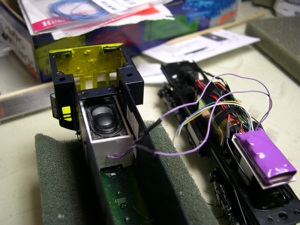
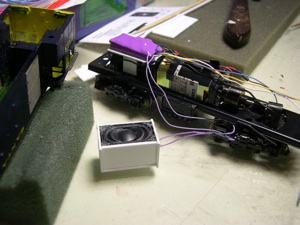
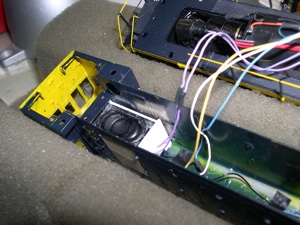
The key to good sound is the box. I made one from styrene to fit the Soundtraxx 810112 small oval speaker. The box is totally sealed with ACC and clear caulk. The decoder, in the purple shrinkwrap, sits on a plastic shelf at the front of the locomotive.
The speaker box-assembly sits at the rear, up against the cab bulkhead. Though you can’t see them, I replaced the 1.5v factory-installed incandescent bulbs with 16v ones, as I don’t particularly like LEDs. Doing so, I had to drill larger holes in the front/rear light housings.



